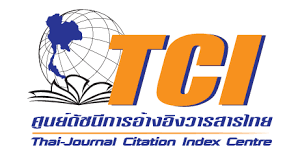EFFECTS OF EDUCATIONAL ERGONOMICS WITH RUBBER CHAIN EXERCISE PROGRAM ON LOW BACK PAIN, FUNCTIONAL ABILITY AND BACK MUSCLE STRENGTH AMONG INDIGO-DYED WEAVING WORKERS
Keywords:
Educational Ergonomic, Rubber Chain Exercise Training, Low Back Pain, Indigo-Dyed Weaving WorkersAbstract
The objective of this research was to examine the effects of educational ergonomics with rubber chain exercise training program on low back pain, functional ability, muscle strength and flexibility among indigo-dyed weaving workers. Data were collected from 60 volunteers, which indigo-dyed weaving workers of Phanna Nikhom district, Sakon Nakhon provice during September to November 2019. A total of 60 volunteers were divided into two groups (experimental and control group), each group consisted of 30 people. The study period was 4 weeks. During the experimental period, the subjects of the experimental group received the educational ergonomics with rubber chain exercise training program. The research instruments included an interview from personal data, numerical retting scale, functional ability questionnaire, and a recording of flexibility and back muscle strength. Comparative analyses were used Independent t-test, Paired Sample t-test, Mann-Whitney U test, and Wilcoxon Signed-Rank test at 95% confidence interval level. The results showed that after implementing the program, the experimental group had significantly lower mean score of low back pain and functional ability than other group and the higher mean score of flexibility and back muscles strength than control group. In addition, after performing the program, the experimental group had significantly lower mean score of lower back pain and functional ability than before performing the program and the higher mean score of flexibility and back muscle strength than before performing the program. Results from this study showed that the educational ergonomics with rubber chain exercise training program can be help relieve low back pain, improve functional ability, increase back muscle strength and flexibility.
References
จตุรงค์ ทองดารา, ทนงศักดิ์ ยิ่งรัตนสุข และสุกัญญา เจริญวัฒนะ. (2558). ผลของการบริหารร่างกายโดย
ใช้ยางยืดเพื่อพัฒนาความอ่อนตัวของกล้ามเนื้อร่างกายส่วนบนในพนักงานโรงงานอุตสาหกรรม.วารสารบทคัดย่อกลุ่มวิทยาศาสตร์และเทคโนโลยี, 1(6), 101-113.
เจริญ กระบวนรัตน์. (2549). ยางยืดพิชิตโรค. กรุงเทพฯ: แกรนสปอร์ต.
เจริญ กระบวนรัตน์. (2557). ยางยืดพิชิตชีวิต. กรุงเทพฯ: พิมพ์ดี.
ฉัตรทิพย์ เพ็ชรชลาลัย และสุวิทย์ อุดมพาณิชย์. (2562). ผลของโปรแกรมการออกกำลังกายด้วยยางยืด
ต่อสมรรถภาพทางกายในผู้สูงอายุไทย. วารสารวิจัยสาธารณสุขศาสตร์ มหาวิทยาลัยขอนแก่น, 12(2), 52-61.
ทิพรัตน์ ล้อมแพน และหทัยรัตน์ ราชนาวี. (2562). ความแข็งแรงอดทนของกล้ามเนื้อภายหลังการออก
กำลังกายด้วยยางยืดในผู้สูงอายุ. วารสารวิทยาลัยพยาบาลบรมราชชนนี นครราชสีมา, 25(2), 148-167.
ทิวาพร โชติจําลอง และรชานนท งวนใจรัก. (2562). ผลของโปรแกรมส่งเสริมสุขภาพตามหลัก
การยศาสตร์ในการทำงานของพนักงานที่ปฏิบัติงานด้านคอมพิวเตอร์ในโรงพยาบาล. วารสารวิชาการ สคร., 25(3), 5-14.
นภมณ ยารวง และโสภาพรรณ อินต๊ะเผือก. (2559). ผลของโปรแกรมการออกกำลังกายด้วยการยืด
เหยียดกล้ามเนื้อต่ออาการปวดหลังส่วนล่างในเกษตรกรชาวนา. วารสารพยาบาลทหารบก, 17(3), 73-81.
น้ำเงิน จันทรมณี, สสิธร เทพตระการพร และผกามาศ พิริยะประสาธน์. (2557). ปัญหาการปวดเมื่อย
กล้ามเนื้อจากการทำงานของกลุ่มอาชีพการทอผ้าด้วยมือในเขตภาคเหนือตอนบนของประเทศไทย.วารสารความปลอดภัยและสุขภาพ, 7(24), 29-40.
เบญญาภา ศรีปัญญา, บรรณสิทธิ สิทธิบรรณกุล และเพชรรัตน์ แก้วดวงดี. (2562). ปัจจัยเสี่ยงที่มี
ความสัมพันธ์กับอาการปวดหลังส่วนล่างจากการทำงานในกลุ่มอาชีพทอผ้าย้อมครามในตำบลนาหัวบ่อ อำเภอพรรณานิคม จังหวัดสกลนคร. การประชุมวิชาการระดับชาติ มหาวิทยาลัยเทคโนโลยีราชมงคล ครั้งที่ 11, 24-26 กรกฎาคม 2562 ณ ศูนย์ประชุมและแสดงสินค้านานาชาติเฉลิมพระเกียรติ 7 รอบพระชนมพรรษา. เชียงใหม่: สถาบันวิจัยและพัฒนามหาวิทยาลัยเทคโนโลยีราชมงคลล้านนา.
ปิยาภรณ์ เพ็ญประไพ, วีระพร ศุทธากรณ์ และธานี แก้วธรรมานุกูล (2560). ผลของการจัดกระทำด้าน
การยศาสตร์ต่อความยืดหยุ่นของกล้ามเนื้อและอาการปวดหลังของคนทำงานแกะสลักไม้. พยาบาลสาร, 44(3), 77-89.
พัชรินทร์ ใจจุ้ม และทัศน์พงษ์ ตันติปัญจพร. (2561). ประสิทธิผลของการจัดโปรแกรมการยืดเหยียด
กล้ามเนื้อร่วมกับการให้ความรู้ด้านการยศาสตร์เพื่อลดอาการปวดเมื่อยหลังและเพิ่มความแข็งแรงของกล้ามเนื้อหลังของคนงานทอผ้าด้วยมือ ตำบลแม่แรง อำเภอป่าซาง จังหวัดลำพูน. วารสารวิทยาศาสตร์และเทคโนโลยี มหาวิทยาลัยอุบลราชธานี, 20(3), 29-39.
สำนักวิทยาศาสตร์การกีฬา กรมพลศึกษา กระทรวงการท่องเที่ยวและกีฬา. (2559). คู่มือแบบทดสอบ
และเกณฑ์มาตรฐานสรรถภาพทางกาย สำหรับประชาชนไทย อายุ 60-80. กรุงเทพฯ: สำนักวิทยาศาสตร์การกีฬา กรมพลศึกษา กระทรวงการท่องเที่ยวและกีฬา.
Chantaramanee, N., Taptagaporn, S., & Piriyaprasarth, P. (2015). The assessment of
occupational ergonomic risks of handloom weaving in northern Thailand. Thammasat International Journal of Science and Technology, 20(4), 29-37.
Cos, JM. (2011). Low back pain: Mechanism, diagnosis, treatment. 7th ed. Philadephia:
Lippincott Williams & Wilkins.
Da Silva, TMJC., da Silva, NN., de Souza Rocha, SH., de Oliveira, DM., Monte-Silva, KK.,
da Silva Tenório, A., & de Araújo, MdGR. (2014). Back school program for back pain: education or physical exercise?. ConScientiae Saúde, 13(4), 506-515.
Dreisinger, TE. (2014). Exercise in the management of chronic back pain. The Ochser
Journal, 14(1), 101-107.
Dupeyron, A., Ribinik, P., Gélis, A., Genty, M., Claus, D., Hérisson, C., & Coudeyreef, E.
(2011). Education in the management of low back pain. Literature review and recall of key recommendations for practice. Annals of Physical and Rehabilitation Medicine, 54(5), 319-335.
Durlov, S., Chakrabarty, S., Chatterjee, A., Das, T., Dev, S., Gangopadhyay, S., Haldar, P.,
Maity, SG., Sarkar, K., & Sahu, S. (2014). Prevalence of low back pain among handloom weavers in West Bengal, India. International Journal of Occupational and Environmental Health, 20(4), 333-339.
Grooten, WJA., Mulder, M., & Wiktorin, C. (2007). The effect of ergonomic intervention
on neck/shoulder and low back pain. Work journal, 28(4), 313-323.
Hossain, A., Kamrujjaman, M., & Malleque, A. (2018). Associated factors and Pattern of
Musculoskeletal Pain among Male Handloom Weavers Residing in Belkuchi, Shirajgonj: A Cross sectional Study. International Journal of Scientific & Engineering Research, 9(10), 1447-1451.
Jakobsen, MD., Sundstrup, E., Brandt, M., Kristensen, A. Z., Jay, K., Stelter, R., Lavendt, E.,
Aagaard, P., & Andersen, LL. (2014). Effect of workplace-versus home-based physical exercise on pain in healthcare workers: study protocol for a single blinded cluster randomized controlled trial. BMC Musculoskeletal Disorders, 15(1), 1-9.
Ma, VY., Chan, L., & Carruthers, KJ. (2014). Incidence, prevalence, costs, and impact on
disability of common conditions requiring rehabilitation in the United States: stroke, spinal cord injury, traumatic brain injury, multiple sclerosis, osteoarthritis, rheumatoid arthritis, limb loss, and back pain. Archives of Physical Medicine and Rehabilitation, 95(5), 986-995.
Mohammadi Zeidi, I., Heydarnia, A., Niknami, S., Safari Variani, A., & Varmazyar, S. (2010).
The effects of an educational intervention on knowledge, attitude and ergonomic behaviors. JQUMS, 14(1), 33-40.
Naz, H., Kwatra, S., & Ojha, P. (2015). Prevalence of musculoskeletal disorders among
handloom weavers of Uttarakhand: an ergonomic study. Journal of Applied and Natural Science, 7(1), 102-105.
Rahman, M., Khan, M., Hossain, I., Bari, S., & Aktaruzzaman, M. (2017). Musculoskeletal
problems among handloom workers. Texila International Journal of Public Health, 5(3), 1-15.
Sanjaroensuttikul, N. (2007). The Oswestry low back pain disability questionnaire
(version 1.0) Thai version. JOURNAL-MEDICAL ASSOCIATION OF THAILAND, 90(7), 1417.
Shariat, A., Cleland, JA., Danaee, M., Kargarfard, M., Sangelaji, B., & Tamrin, SBM. (2018).
Effects of stretching exercise training and ergonomic modifications on musculoskeletal discomforts of office workers: a randomized controlled trial. Brazilian Journal of Physical Therapy, 22(2), 144-153.






